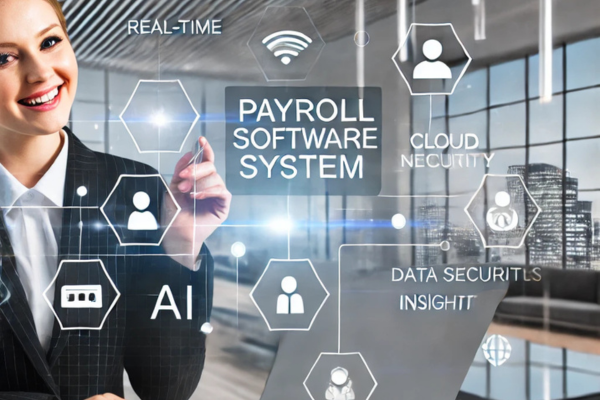In episode #7 of the DER Payroll Podcast, my guest is Uwe Klappich, Cluster Lead for Payroll Technology at SD Worx. We talk about the use of artificial intelligence (AI) and innovations in payroll. Klappich, who is leading the development of a new in-house payroll software, explains how this technology can make work processes more efficient and what opportunities and challenges it presents for companies and payroll accountants.
Sabine Katzmair: Mr Klappich, do you personally already use AI applications such as ChatGPT or other tools in your daily work?
Uwe Klappich: Yes, definitely! I use ChatGPT and Gemini from Google, but only privately so far. AI tools like these are extremely practical for finding answers quickly, developing ideas and discovering alternative perspectives. Of course, it’s a bit more complicated when it comes to business data. Data privacy and security are very important, so I don’t use external AI applications for our company data yet. But I use AI almost every day in my personal life. The ability to ask questions and then tailor the answers to my needs is really helpful. For example, you can generate more polite or more detailed answers – this saves time and provides new ideas.
Sabine Katzmair: Why did SD Worx decide to develop its own payroll system when there are already numerous solutions on the market?
Uwe Klappich: Good question! With 75 years of experience in the payroll sector, we really know the specific needs of our customers. As a result, we have been able to develop a solution that is precisely tailored to the requirements that we have identified from customer feedback over the years. Having our own system also gives us the flexibility to respond more quickly to market changes and regulatory requirements. Many off-the-shelf solutions may be good, but they often leave less room for customisation. We want to offer our customers the best possible user experience and accuracy, without being dependent on third-party vendors or their update cycles.
Sabine Katzmair: In our previous interview you mentioned that your system is ‘smart’ or intelligent. Can you elaborate on that? Can we already talk about real AI?
Uwe Klappich: Our new payroll system uses algorithms that are tailored to the customer’s data and processes and react accordingly. You could call it ‘process-driven intelligence’. This means that the software can automatically adapt processes and make recommendations to reduce the user’s workload and avoid errors. However, this is not yet self-learning AI in the classic sense. It is more about intelligently applying existing knowledge and rules to help our customers. For example, the system recognises unusual entries and provides immediate feedback. This makes it easier for a payroll administrator to keep track of things, which is particularly helpful when working with complex or rapidly changing rules.
Sabine Katzmair: A particularly innovative feature of your software is real-time payroll. You say that this eliminates the need for test payrolls. How exactly does this work?
Uwe Klappich: Our new payroll system uses algorithms that are tailored to the customer’s data and processes and react accordingly. You could call it ‘process-driven intelligence’. This means that the software can automatically adapt processes and make recommendations to reduce the user’s workload and avoid errors. However, this is not yet self-learning AI in the classic sense. It is more about intelligently applying existing knowledge and rules to help our customers. For example, the system recognises unusual entries and provides immediate feedback. This makes it easier for a payroll administrator to keep track of things, which is particularly helpful when working with complex or rapidly changing rules.
Sabine Katzmair: A particularly innovative feature of your software is real-time payroll. You say that this eliminates the need for test payrolls. How exactly does this work?
Uwe Klappich: The idea of real-time payroll is that all entries are processed and calculated immediately – very similar to an Excel spreadsheet that updates itself immediately when you change a cell. It works the same way for us: the payroll administrator sees the results of each entry immediately and can react to any discrepancies without having to run a separate test payroll at the end of the month. The result can be viewed at any time and is exactly the same as the final payroll. An example: If an employee receives a pay rise, you can immediately see how this will affect the entire payroll process. This saves us time and allows us to correct errors quickly. Ultimately, it’s about making the process more efficient and secure.
Sabine Katzmair: The recently passed AI law places high demands on data protection. How do you ensure that sensitive customer data is processed securely when you rely on AI and automation?
Uwe Klappich: The AI Act and the German Data Protection Act are very important, and we are very careful to comply with all the requirements. For the most part, we use anonymous or aggregated data to gain insights without analysing personal data. This ensures that no individual data is unnecessarily processed or shared externally. Our goal is to improve processes for our customers without putting their data at risk. When we do use personal information, we do so with your explicit consent and under strict security measures. In the long term, we see it as an advantage if customers know that their data is safe and transparent with us, so that we can further optimise our system without taking any data protection risks.
Sabine Katzmair: This sounds like a big step towards automation. What does this mean for the future of payroll accounting? Will there be less demand in the future?
Uwe Klappich: Payroll accountants will continue to play an important role, but their tasks will shift. They will increasingly take over data verification and process monitoring, while the software will take over data entry and calculation. Data entry will become less manual and more automated, so that payroll accountants will primarily ensure the accuracy and completeness of processes and support strategic decisions. This is a change, but not a decrease in demand – rather the nature of the work will change. Education and training will play an important role, as users need to understand how to work efficiently with the technology.
Sabine Katzmair: There is often a cliché that payroll is all about pushing a button every month. Will this ‘push the button’ scenario become a reality in the near future?
Uwe Klappich: Actually, we are aiming for a scenario without ‘pushing a button’! In our system, everything is processed continuously and in real time. This means that there is no longer a separate invoicing process that you have to start – you just have to say when everything is ready for the month. Then the ‘lid’ is closed, all the data is finalised and the invoicing is complete. This is a real simplification as it minimises human error in the final payroll run and all entries are checked directly.
Sabine Katzmair: And finally, to what extent do you see Smart Payroll helping companies to better master digitalisation?
Uwe Klappich: Digitalisation often fails because of media discontinuities and disjointed processes. Our system enables companies to process payroll, tax data and everything else seamlessly and electronically. We have built in wizards and task lists to help understand and execute the processes correctly. This all-digital solution frees up HR departments to focus on strategic tasks. Our mission is to make digitalisation easier and more tangible so that companies can focus on their core competencies.
Sabine Katzmair: Thank you very much, Mr Klappich, for this comprehensive insight! It will be exciting to see how AI and automation in payroll will continue to develop. Thank you very much for your time!
________________________________________________________________________________________________________________
Want to listen to the whole episode in German? Click here for all podcast episodes



